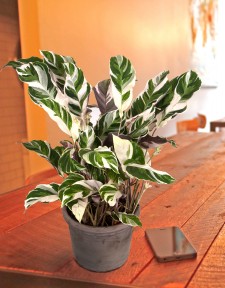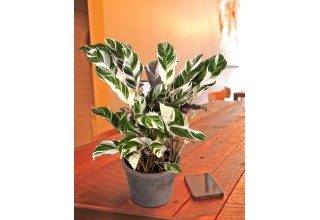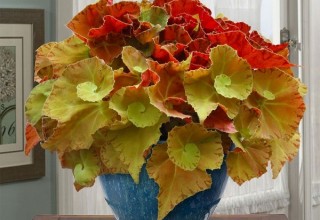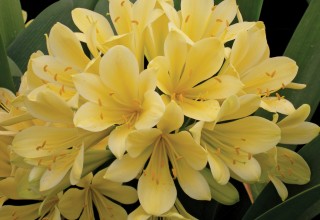
Byron Martin and Laurelynn Martin, the third-generation owners of Logee's Plants, say the three biggest factors of successful indoor growing are knowing how much light a plant needs, knowing how much water it needs and selecting the right plant for the growing conditions in the room.
DANIELSON, Conn., March 7, 2019 (Newswire.com) - Houseplants are trending all over social media. That’s because apartment dwellers and homeowners who have never grown plants are adding plants to their indoor spaces.
Indoor plants are hot for many reasons. They bring a natural design element into what can otherwise be stark, sterile environments. Plants add oxygen to homes and offices, which can make us feel better. And a healthy plant looks great in any room.
“Many studies show the benefits that houseplants bring to the home and the workplace,” said Lisa Eldred Steinkopf, who is known as The Houseplant Guru. “Plants clean the air and they make people feel happier and actually lower their blood pressure. In office environments, plants also reduce the occurrence of sick days.”
Randall D. Schultz, content editor of www.HomeGardenandHomestead.com, says anyone can grow houseplants — even if they’ve never grown plants before. “All you have to do to successfully grow a plant is pay attention to the plant and meet its basic needs,” said Schultz.
Byron Martin and Laurelynn Martin, the third-generation owners of Logee’s Plants, say the three biggest factors of successful indoor growing are knowing how much light a plant needs, knowing how much water it needs and selecting the right plant for the growing conditions in the room.
For those who are beginners to growing houseplants, the Martins have compiled a selection of six easy-to-grow houseplants that are both beautiful and unusual. Three of the plants offer great-looking foliage and the other three plants feature gorgeous blooms.
EASY-TO-GROW FOLIAGE PLANTS
“When selecting houseplants, most beginners have the best success with foliage plants,” said Byron Martin. “The newest hybrids go far beyond plain green leaves, so it’s easy to get a lot of beauty and interest by selecting the right plants.”
The three plants below should work well for virtually everyone.
White Fusion Peacock Plant
The White Fusion Peacock Plant is a terrific choice for those new to growing houseplants. This Calathea hybrid has attractive leaves with alternate streaks of light and dark green. The undersides of the leaves are purple, which adds color to an already-impressive plant. White Fusion Peacock Plant is also one of the best air-cleaning plants for indoor spaces. It can be used to enliven any bright room or partially sunlit window.
‘Martha Stewart’ Begonia
Martha Stewart, the celebrity known best for her home and garden design projects, is a frequent visitor at Logee’s Greenhouses in Danielson, Connecticut. During one of her visits, Martha personally selected the begonia that would become her namesake.
The elegant Begonia "Martha Stewart" has deeply spiraled leaves in soft tones of tan, chartreuse and bronze. In summer, the older leaves turn a deep shade of orange-bronze. A halo of small pink flowers rises above the foliage during the winter months when color is such a welcome treat. "Martha Stewart" is a compact grower that reaches 6-8 inches tall and it fits nicely on a tabletop near a bright eastern- or western-facing window.
Alocasia ‘Frydek’
Alocasia "Frydek" is an outstanding potted plant for the home, apartment or office. The mature leaves are large and velvety green with tones of black. The striking white veins in the leaves make this variety a standout among easy-to-grow houseplants. The juvenile leaves are a bright lime-green and the pale leaf stems have a purplish jagged banding which adds even more color to this attractive plant. These plants are native to tropical areas, so they grow best in temperatures above 65 degrees. Alocasia "Frydek" will grow in partial sun or shade.
EASY-TO-GROW FLOWERING PLANTS
“One of the questions I get asked the most is, ‘What are the best flowering plants for growing in containers?’” said Byron Martin. “Growing flowering plants indoors continues to be popular because people want to be close to blooming plants even inside their homes.”
Here are three of his favorites.
Desert Rose ‘Joyful’
Adeniums, known by the common name Desert Rose, are terrific plants that are native to warm arid and semi-arid regions of Asia. A wide variety of hybrids are available that flower in bright colors ranging from pink to red with white highlights. "Joyful" is a new Desert Rose (Adenium obesum hybrid) from India with stunning pink flowers highlighted with creamy-white petal edges and white around the throat. Desert Rose is a beautiful sight when in full bloom because the colorful flowers offset the narrow green leaves. Adeniums thrive where environmental conditions are warm and sunny. Logee’s sells "Joyful" as a ready-to-bloom, one-year-old plant.
Cape Primrose ‘Remembering John’
Cape Primroses (Streptocarpus hybrids) are delightful flowering plants that stay small. Because of their petite size (just 6 -12 inches tall), Cape Primroses fit nicely on windowsills and tabletops. They like bright light and can handle some partial sun.
The blossoms on Cape Primrose "Remembering John" are a mix of purple, dark blue and white. There is deep purple veining in the throat of each blossom and the undersides are white. Like most easy-to-grow Cape Primroses, "Remembering John" is perfect for beginners who have never grown a flowering houseplant before. "Remembering John" will flower well on a partially sunlit window or even under fluorescent lighting.
‘Good Hope’ Clivia
Clivias are popular, easy-to-grow houseplants for good reason. They are tough and resilient members of the amaryllis family and they flower profusely. "Good Hope" is a new strain of Clivia miniata that has long green leaves and bright yellow flowers.
Clivia "Good Hope" will perform best in partial sunlight. It blooms in clusters of sunshine-yellow flowers that last from February to May. To ensure flowering, give this plant cool, dry conditions during the late fall and early winter “resting period."
All the plants featured in this story are available at Logees.com.
Source: Logee's Plants
Share:



